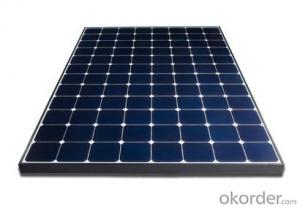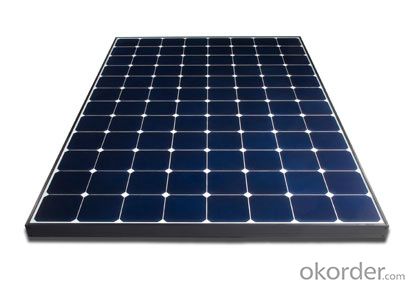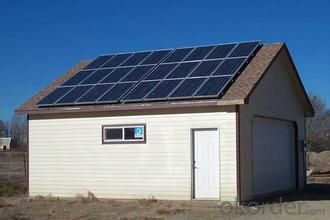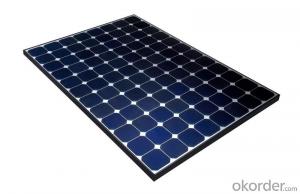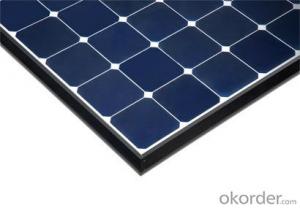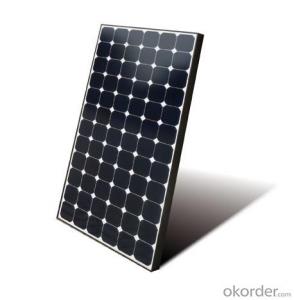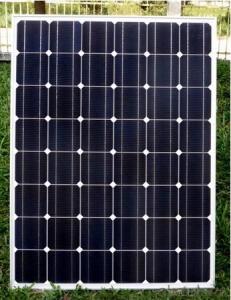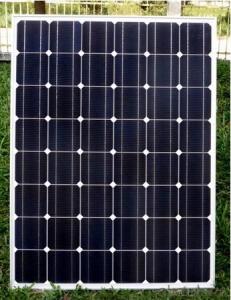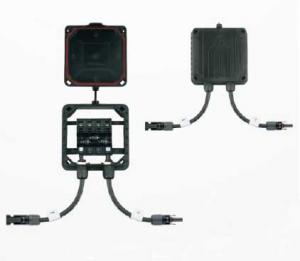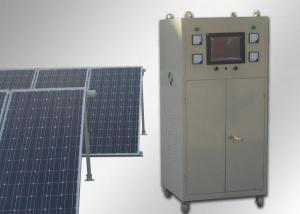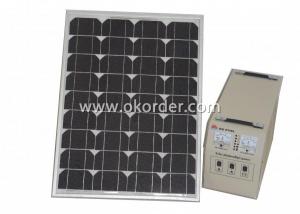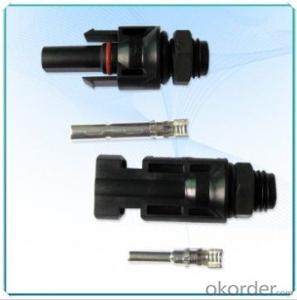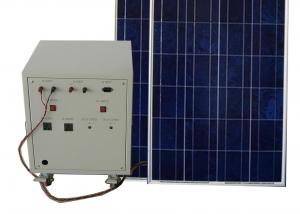Solar Energy Systems Wholesale - CNBM On Grid System 40000W with Certificate UL, TUV, CE
- Loading Port:
- Shanghai
- Payment Terms:
- TT OR LC
- Min Order Qty:
- 10 watt
- Supply Capability:
- 1000 watt/month
OKorder Service Pledge
OKorder Financial Service
You Might Also Like
Specification
CNBM On Grid System 40000W with Certificate UL TUV CE
Product description
A photovoltaic (in short PV) module is a packaged, connected assembly of typically 6×10 solar cells. Solar Photovoltaic panels constitute the solar array of a photovoltaic system that generates and supplies solar electricity in commercial and residential applications. Each module is rated by its DC output power under standard test conditions, and typically ranges from 100 to 365 watts. The efficiency of a module determines the area of a module given the same rated output – an 8% efficient 230 watt module will have twice the area of a 16% efficient 230 watt module. There are a few commercially available solar panels available that exceed 22% efficiency[1] and reportedly also exceeding 24%.[2][3] A single solar module can produce only a limited amount of power; most installations contain multiple modules. A photovoltaic system typically includes a panel or an array of solar modules, a solar inverter, and sometimes a battery and/or solar tracker and interconnection wiring.
The price of solar power, together with batteries for storage, has continued to fall so that in many countries it is cheaper than ordinary fossil fuel electricity from the grid (there is "grid parity").[4]
Off-the-grid is a system and lifestyle[1] designed to help people function without the support of remote infrastructure, such as an electrical grid. In electricity, off-grid can be stand-alone power system or mini-grids typically to provide a smaller community with electricity. Off-grid electrification is an approach to access electricity used in countries and areas with little access to electricity, due to scattered or distant population. The term off-the-grid (OTG) can refer to living in a self-sufficient manner without reliance on one or more public utilities. People who adopt this lifestyle are called off-gridders.[2]
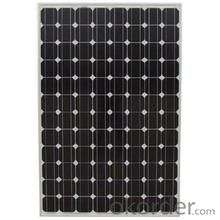
Application
Industrial
Commercial
Residential
Feature
Residential, grid-connected rooftop systems which have a capacity more than 10 kilowatts can meet the load of most consumers.[2] They can feed excess power to the grid where it is consumed by other users. The feedback is done through a meter to monitor power transferred. Photovoltaic wattage may be less than average consumption, in which case the consumer will continue to purchase grid energy, but a lesser amount than previously. If photovoltaic wattage substantially exceeds average consumption, the energy produced by the panels will be much in excess of the demand. In this case, the excess power can yield revenue by selling it to the grid. Depending on their agreement with their local grid energy company, the consumer only needs to pay the cost of electricity consumed less the value of electricity generated. This will be a negative number if more electricity is generated than consumed.[3] Additionally, in some cases, cash incentives are paid from the grid operator to the consumer.
Packaging
With carton and box
- Q: Can solar energy systems be used in areas with high levels of seismic activity?
- Yes, solar energy systems can be used in areas with high levels of seismic activity. However, additional precautions and engineering considerations need to be taken into account during the design and installation process. This involves ensuring that the solar panels and other components are properly secured to withstand the potential effects of earthquakes. By implementing appropriate measures, such as using flexible mounting systems and reinforcing structures, solar energy systems can be made resilient and safe in seismic-prone regions.
- Q: Are there any fire risks associated with solar energy systems?
- Yes, there are fire risks associated with solar energy systems, although they are relatively low compared to other energy sources. The most common fire risks include electrical malfunctions, such as faulty wiring or connectors, and overheating of components. However, modern solar systems are designed with safety measures, such as built-in fire barriers and automatic shut-off mechanisms, to minimize these risks. Regular maintenance and inspections by qualified professionals can further reduce the chances of fire incidents.
- Q: Can a solar energy system be installed on a shopping center or mall?
- Yes, a solar energy system can be installed on a shopping center or mall. In fact, many shopping centers and malls around the world are now utilizing solar panels to generate electricity. The large rooftop spaces available in these establishments make them ideal for solar installations. By harnessing the power of the sun, shopping centers and malls can significantly reduce their reliance on traditional energy sources, lower their carbon footprint, and reduce their energy costs. Furthermore, solar energy systems can also be integrated into parking lots or carports, providing shade for vehicles while simultaneously generating clean energy. Overall, installing a solar energy system on a shopping center or mall is a viable and sustainable solution for meeting their energy needs.
- Q: Can solar energy systems be used in powering music studios or recording studios?
- Certainly, music studios or recording studios can definitely utilize solar energy systems for power. Solar power systems present a clean and renewable energy source that offers a reliable and economical solution for operating various electrical equipment, including the energy-intensive equipment typically found in music studios. To harness sunlight and convert it into electricity, solar panels can be installed on the studio building's roof or any other suitable area. This generated electricity can then effectively power a diverse range of equipment, such as amplifiers, mixers, microphones, computers, lighting fixtures, and air conditioning systems. The required size of the solar power system will depend on the studio's energy needs. By analyzing the studio's energy consumption patterns and demands, solar energy experts can design and install a tailor-made solar power system that perfectly suits the studio's specific requirements. One major advantage of utilizing solar energy in music studios is the potential for significant cost savings. Traditional electricity sources, especially in commercial settings, can be quite expensive. However, by generating their own electricity through solar power, studios can reduce their reliance on the grid and potentially diminish their electricity bills. Furthermore, solar energy is an environmentally friendly and sustainable option. Music studios often consume a substantial amount of electricity, and using solar power can help minimize their carbon footprint and contribute to a more environmentally conscious future. It is important to note that solar energy systems can also be combined with battery storage systems. This allows music studios to store excess energy produced during the day and utilize it during periods of low solar generation or at night. This further enhances the reliability and independence of the solar power system. In conclusion, solar energy systems can be effectively employed to power music studios or recording studios. They provide a clean, renewable, and cost-effective solution that can meet the energy demands of these facilities while simultaneously reducing their environmental impact.
- Q: How do solar energy systems affect property value?
- Solar energy systems can have a positive impact on property value as they are seen as a valuable and sustainable addition to a home. Studies have shown that homes with solar panels tend to sell faster and at a higher price compared to similar homes without solar systems. Additionally, solar energy systems can help reduce utility bills, making the property more attractive to potential buyers.
- Q: Can solar energy systems be used for heating and cooling homes?
- Solar energy systems have the potential to be utilized for both heating and cooling homes. The energy from the sun can be captured by solar panels or solar water heaters to generate electricity or heat, which can then be used to power heating and cooling systems within homes. For heating purposes, there are various methods in which solar energy can be employed. Solar thermal systems can be installed to warm water for radiant floor heating or produce steam for heating purposes. Solar air heating systems are another option, as they can warm the air that can be distributed throughout the house using ductwork and fans. Additionally, solar heat pumps can be utilized to transfer heat from the sun into the home. In a similar vein, solar energy can also be effectively utilized for cooling homes. Solar-powered air conditioning systems can be employed, utilizing solar energy to operate the compressors and fans necessary for cooling. These systems are particularly advantageous in regions with hot climates, where sunlight availability aligns with the need for cooling. The use of solar energy systems for both heating and cooling offers numerous benefits. First and foremost, solar energy is a clean and renewable source of energy, which reduces reliance on fossil fuels and minimizes carbon emissions. Furthermore, the use of solar energy systems provides long-term cost savings, as they decrease or eliminate the need for traditional heating and cooling methods that rely on grid electricity or fossil fuels. Additionally, solar energy systems can be easily integrated into existing homes or included in new construction projects, making them a versatile and sustainable option for heating and cooling residential properties.
- Q: What is the role of solar energy systems in reducing water usage?
- Solar energy systems can play a crucial role in reducing water usage by providing a sustainable and efficient alternative to conventional energy sources. By harnessing the power of the sun, solar energy systems can generate electricity without relying on water-intensive processes such as cooling or steam generation, which are common in thermal power plants. Additionally, solar-powered irrigation systems can be used in agriculture, minimizing the need for water-intensive irrigation techniques. Overall, solar energy systems help reduce water consumption and promote sustainable water management practices.
- Q: Can solar energy systems be used in powering sports stadiums?
- Yes, solar energy systems can definitely be used to power sports stadiums. In fact, many stadiums around the world have already started implementing solar energy systems to meet their energy needs. Solar panels can be installed on the rooftops, parking lots, or open spaces surrounding the stadium to capture sunlight and convert it into electricity. The main advantage of using solar energy in powering sports stadiums is its sustainability and cost-effectiveness. Solar energy is a renewable source of energy that does not emit any greenhouse gases during its operation, making it environmentally friendly and helping to reduce carbon footprint. Moreover, once the initial investment is made in installing the solar panels, the ongoing operational costs are relatively low, which can result in significant savings on the stadium's energy bills. The size and structure of sports stadiums make them ideal candidates for solar energy systems. The large surface areas of stadiums provide ample space for installing a significant number of solar panels, which can generate a substantial amount of electricity. Additionally, the open spaces surrounding the stadium allow for optimal sunlight exposure, ensuring maximum energy generation. Furthermore, solar energy systems can be integrated with other technologies to enhance their efficiency and functionality. For instance, battery storage systems can be employed to store excess energy generated during the day and use it during night events or during periods of low sunlight. This ensures a continuous and reliable power supply to the stadium, regardless of the weather conditions or time of day. In conclusion, solar energy systems can definitely be used in powering sports stadiums. They offer a sustainable and cost-effective solution to meet the energy needs of these large facilities, while also reducing their environmental impact. With further advancements in solar technology and decreasing costs, it is expected that more sports stadiums worldwide will embrace solar energy as a primary source of power in the future.
- Q: Can solar energy systems be used in areas with limited sunlight?
- Yes, solar energy systems can still be used in areas with limited sunlight. While areas with abundant sunlight are ideal for solar energy generation, advancements in solar technology have made it possible to generate electricity even in areas with less sunlight. These systems can still produce a significant amount of energy by capturing and converting sunlight, albeit at a reduced efficiency. Additionally, energy storage solutions such as batteries can help store excess energy for use during periods of low sunlight.
- Q: What is the role of solar energy systems in reducing dependence on fossil fuels?
- The use of solar energy systems is vital in decreasing reliance on fossil fuels as they offer a clean and renewable energy source. For centuries, coal, oil, and natural gas have been the primary sources of energy; however, their extraction, transportation, and combustion have had significant environmental effects, including air pollution, greenhouse gas emissions, and climate change. Conversely, solar energy systems utilize the sun's power to generate electricity. Solar panels, composed of photovoltaic cells, convert sunlight into usable energy without emitting harmful pollutants. This clean energy source not only helps combat climate change but also enhances air quality and reduces health hazards associated with burning fossil fuels. By adopting solar energy systems, we can lessen our dependence on fossil fuels for electricity generation, heating, and cooling. Solar power is abundant, widely available throughout the year, and can be relied upon, making it a dependable and sustainable energy option. Moreover, solar energy systems can be installed on various scales, from residential rooftops to large-scale solar farms, allowing individuals, communities, and businesses to contribute to the shift away from fossil fuels. Solar energy not only decreases our carbon footprint but also provides economic advantages. As technology advances and becomes more widespread, the cost of solar panels and installation continues to decrease. This makes solar energy more affordable and accessible for both individuals and businesses, leading to job creation and economic growth in the renewable energy sector. Additionally, solar energy systems offer energy independence and resilience. Unlike finite fossil fuel resources that are subject to price volatility, sunlight is abundant and freely available. By harnessing solar power, we can reduce our dependence on imported fossil fuels, strengthen energy security, and establish a more stable and sustainable energy supply. In conclusion, solar energy systems have a critical role in reducing reliance on fossil fuels. By harnessing the sun's power, we can transition to a cleaner, more sustainable, and resilient energy future. Solar energy aids in mitigating climate change, improving air quality, creating jobs, and providing energy independence. It is a viable solution that allows us to decrease our environmental impact while meeting our energy requirements.
Send your message to us
Solar Energy Systems Wholesale - CNBM On Grid System 40000W with Certificate UL, TUV, CE
- Loading Port:
- Shanghai
- Payment Terms:
- TT OR LC
- Min Order Qty:
- 10 watt
- Supply Capability:
- 1000 watt/month
OKorder Service Pledge
OKorder Financial Service
Similar products
Hot products
Hot Searches
Related keywords
